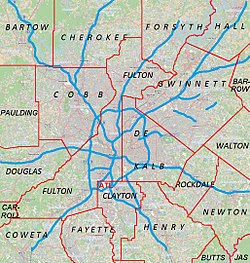Rest Haven, Georgia | |
|---|---|
Town | |
 Georgia State Route 13 in Rest Haven | |
 Location in Gwinnett County and the state of Georgia | |
Location in Metro Atlanta | |
| Coordinates: 34°7′59″N83°58′36″W / 34.13306°N 83.97667°W | |
| Country | United States |
| State | Georgia |
| Counties | Gwinnett, Hall |
| Government | |
| • Mayor | Kenneth Waycaster [1] |
| • City Clerk | Monica Montgomery |
| Area | |
• Total | 0.15 sq mi (0.40 km2) |
| • Land | 0.15 sq mi (0.40 km2) |
| • Water | 0.00 sq mi (0.00 km2) |
| Elevation | 1,099 ft (335 m) |
| Population (2020) | |
• Total | 45 |
| • Density | 290.32/sq mi (112.34/km2) |
| Time zone | UTC-5 (Eastern (EST)) |
| • Summer (DST) | UTC-4 (EDT) |
| FIPS code | 13-64792 [4] |
| GNIS feature ID | 332834 [3] |
Rest Haven is a town primarily in northern Gwinnett and partly in southern Hall counties in the U.S. state of Georgia. As of 2020, its population was 45.
Contents
Rest Haven is located along Georgia State Route 13, a highway from Atlanta to Gainesville that is immediately west of Interstate 985. The Gwinnett County portion of Rest Haven is part of the Atlanta–Sandy Springs–Marietta, GA-AL metropolitan statistical area, while the Hall County portion is part of the Gainesville, GA metropolitan statistical area.


